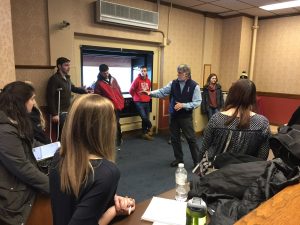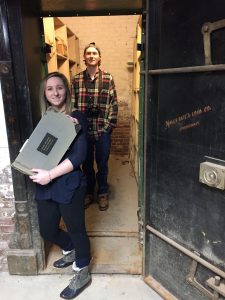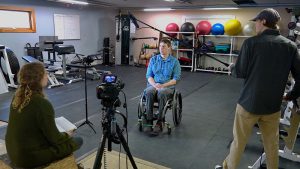by Roy Stever, Plymouth State Business & Marketing Faculty

Roy’s reflection was originally published by the CoLab as a series, but is republished here as in its entirety. Roy looks forward to working with the CPLC in July as we talk together about Project-Based Learning.
In the Fall of 2016, our group of three PSU faculty members embarked on a cluster “adventure” in the North Country of New Hampshire. We were not specific about “what” we were going to do, or particularly “how” we would mobilize students through engaged learning in the community. We were guided only by the passionate input of community leaders in Lancaster NH, and our own instincts. They were looking for PSU’s help in stimulating several community development interests. We, as faculty, were interested in addressing underlying economic and social challenges in the region and engaging students in both learning and “solving”.
Spring 2017 brought together sixty students across ten academic majors, enrolled in four courses in business and graphic arts, and working in seven cross-course teams. Each team was responsible for communicating with an identified partner in Lancaster to both “scope” needs and propose specific solutions and plans. Projects ranged from energizing Main Street, to assisting entrepreneurs in realizing immediate market opportunities. Major efforts centered on developing build-out concepts for the recently-acquired, historic Lancaster National Bank building, as well as specific marketing support for Peter Rizzo (Fitness Professional), trainer and founder/owner of RizFit. Another important area of inquiry involved constructing various personas of young, transitional adults based on interviews with 16 individuals who had found “pathways” of personal and professional success in the region.
The original “Lancaster Project” took on expanded scale in the North Country through six discrete year-long cluster projects in AY 2017/2018. A continuing effort with RizFit was augmented by new teams working with Northern Gateway Chamber of Commerce and Colonel Town Recreation in Lancaster, the Studio School in Littleton, and the Town of Lisbon. Another team examined various means of stimulating French-speaking tourism across the region.
Attention turned in AY 2018/2019 to refining our North Country “community builders” targets, of all ages, in the North Country while developing new points of PSU value – APEX business training to support entrepreneurs and promising non-profit organizations and a Healthy Communities initiative designed to assist community leaders identify and address priority social and economic needs in individual towns.
To date, after five semesters, PSU’s North Country Community Development (NCCD) initiative has engaged over 200 students in challenging encounters with community partners, delivering solutions, recommendations, plans and ideas, with impact for towns, businesses and non-profits. The program has grown to now include six energetic faculty members, representing the arts, language, history, health education and business. Plans are underway to reach out to new communities, Gorham and Berlin.
It is safe to say that NCCD can continue grow, with a healthy “stable” of projects in the region, and the continued commitment of PSU.
Starting-Out
Before setting out on a cluster or open-lab engagement, you may want to first be sure of your own motivations, before considering the “win” for students, collaborators, the partner(S) or PSU. In all likelihood, if the project is conceived as part of a deeply-held belief or passion and you can spot an unmet need, then the rewards for the other stakeholders will be high, as well. Given the time and mental transposition of converting traditional teaching approaches in to experiential learning, you – and especially you – need to be all in. The others will more easily understand your idea and share the excitement, becoming contributors and not falling victim to the inevitable trepidation.
If you otherwise accept the constraints imposed by other parties (e.g. a student reticence, limiting academic schedule, the need for rapid payback, an unrealistic partner organization), you will quickly lose heart.
This was the easy part for me, from the very first call-to-action for cluster activity. A number of us were actively considering PSU’s support to the North Country at the time. Clusters became an immediate canopy under which we could solve a number of puzzles around collaboration, student engagement, funding and mandate. The point is, though, that the opportunity had already been framed – in my case, by a life-long frustration that the North Country of New Hampshire is somehow fated to a marginal existence for many, including entrepreneurs, artists and small business owners who were simply missing out on a few key fundamentals. Those missing pieces were absolutely within the grasp of our juniors and seniors, and could be successfully passed along under the guidance of committed faculty. For me, it was worth a try.

My ”why” didn’t need to be the same as anyone else’s, not even collaborators, in order to grow the excitement. Indeed, over nine years of teaching, my inspiration was shaped by early events – my wife and I joined Rachelle Lyons (Research Assistant Professor of Environmental Studies) and her environmental science students on two field trips, cleaning up garbage in a scenic river and assessing environmental damage in our town. Next, Pam Anneser’s (Associate Professor, Graphic Design) PSU Student Design Course and Eric Spieth’s (Contract Faculty, Entrepreneurship) APEX Accelerator provided fundamental business and branding support to entrepreneurs and small business owners. Engaging with Denise Normandin (Teaching Lecturer/Project Director) and health education students around Blue Zones has informed the North Country healthy living initiative, and Suzanne Gaulocher (Assistant Professor, Health and Human Enrichment) now brings great expertise in the area of community readiness. Kate Harrington’s (Associate Professor of French) existing Bienvenue NH initiative addresses an important dimension around French tourism development, while Linda Upham Bornstein’s (Teaching Lecturer, History) deep personal engagement in Lancaster has guided a showcase learning experience for highly energized students over five semesters at RizFit. My point – each of us come with a different set of motivations, all deeply held and mutually supportive, a great collaboration.
What is it that you are really most excited about? Find that first, without worrying about other stakeholders just yet. Then, watch the ideas grow!
Community Partners I: Managing Expectations (including our own)
In course preparation, the completion of a syllabus marks one shining moment of perfection, as all that remains is our flawless delivery. Or so we might tell ourselves at the start of each new semester. Once we introduce a partner to course planning, however, we may need to rethink “perfection”. In fact, it is likely that partners will periodically confound all our good planning. The good news is that these excursions – a change of objectives, a new deadline, a mixed message – will benefit our students as they learn about the “real world”. In that sense, simply following a well-planned syllabus falls short of the expectation of full academic preparation and it is partners who provide us an important portal to experiential learning.

The challenge of finding partners for the North Country Community Development (NCCD) initiative – roughly ten over three years – has varied widely. That is good news since there is no one set model and many approaches can work. Community partnerships have ranged from the obvious to the unexpected, and from close-by to far-away. Some dropped in our laps while others took months of intensive cultivation. We have drawn our partners from the ranks of entrepreneurs, non-profits, municipal organizations and loose assemblages of thought-leaders. Some prospects have never reached active status and remain in the stable of untapped projects.
You may learn of prospective partners through word of mouth, research, a news article, general reputation or, perhaps, they will appear in front of you, unannounced. If your program has an advisory board, networking with its members can be quite fruitful. Also, take a close look at the alumni base within your field of exploration, perhaps as part of a wider advanced search of Linked-In. All of the successful projects, though, grew from a meaningful meeting of the minds and a clear sense of mutual benefits well in advance of that first meeting with students.
It does not really matter how you find them but what happens next is crucial.
Initially, you will to make the contact – directly, enthusiastically and with complete transparency. From the start, it will be important to not oversell the capabilities of your student group and not undersell your expectations of the partner. There will likely follow several conversations through which you first explore needs and opportunities through careful listening, then identify a possible path forward. A second “working” stage, face-to-face, is likely to uncover key insights that lie beneath the obvious overarching project mission – unforeseen dimensions that will allow you to build out exciting learning objectives. The third and confirming stage becomes a moment of truth in which the parties declare both what they expect to deliver and what they expect in return.
What you expect to deliver depends entirely on your own programmatic value statement, whether that is based on research, idea development, delivery of knowledge and/or skills, etc. These “deliverables” should be clear to the partner too. Examples of prior student work, projects etc. will go a long way to illuminating the subject. What you expect in return should also be clarified, meeting the following generalized guidelines.
The partner should voluntarily express, in their own words, an interest in students, student-learning and the greater success of PSU. If this does not happen, you may need to prompt the partner. The central importance of students must not be an “afterthought”
You need to share the desired Student Learning Outcomes (SLO’s) for the engagement, including the general metrics by which you will assess student success. The partner has a shared interest in making this work.
Both you and the partner need to commit to the timeline, interim and final milestones, project assessment and a method of “checking-in”.
More will be said in a future post regarding a Memorandum of Understanding (MOU) between PSU and the Partner. Some may view this document with disdain as bureaucratic, although a well-crafted MOU can raise the sense of obligation on the part of both parties while also surfacing possible risk issues and limiting liability.
A few cautions are noteworthy as you evaluate partnerships.
A shallow definition of SLO’s may indicate that there is simply not enough value to pursue the opportunity. Simply expecting the learning to happen as you go is more likely to lead to a “sand-box” experience, the results of which are impossible to predict.
Beware of organizations who are in distress, or simply rudderless, as the expectations will be very high and chances of meaningful impact very low. If they have been unable to find success, it is unlikely that your students will be much more successful.
Projects funded beyond the level of PSU’s cost and/or a modest return on student costs of tuition represent a risk that PSU becomes an unwitting partner in advocacy or “selling ideas”, rather than experiential learning. These programs, if pursued, need to be guided by an explicit written statement of individual and joint interests that becomes a guiding document in the event of ethical concerns. All PSU participants, students included, should be pre-trained through CITI.

Finally, the best partners are often leaders within their “community” or “competitive space”. That does not necessarily mean they are the biggest, wealthiest or most successful. Rather, leadership implies that they have something to teach our students, and us. Happily, most potential partners, even the leaders, are in some sort of deficit organizationally, and that is where we come in. Students, under our guidance, have the ability to work on those issues that may round out a business model, a new market opportunity or simply address an organizational Achilles heel. It is the imbalance in these organizations that provides an opportunity for students to experience both excellence and improvement.
Finding good partners is among the most perplexing of topics in experiential learning models, without question. An “eyes-open”, listening approach coupled with a strong sense of your students’ learning opportunity are at the heart of solving this puzzle. Make it meaningful, not necessarily perfect!
Student Learning
The Student
Students arrive in our classes with varying levels of preparation for a cluster/open lab engagement. Some seem to come with a positive sense of the real world, imbued with confidence, possessing great interpersonal skills and energy, and equipped with technical knowledge of one or more disciplines. One such individual enrolled in two aligned courses as a graphic design major with a marketing minor. What we did not know was that he also had videography skills and knew all about crowdfunding. He was so excited to be involved in NCCD that we honestly worried about burn-out, but his combined contribution was key to our early branding success and GoFundMe campaign with RizFit, a fitness training studio in Lancaster, NH.
At the other end of the spectrum, there were students in the early going who made a blind decision to enroll, and were quite surprised to learn that they were expected to travel, meet with a client, work on a team, and communicate regularly with students in another course across campus. Good coaching, encouragement and early assignment to teams provided a level of confidence and understanding necessary to move forward in most cases. Very few students, less than 2%, have dropped or failed in these courses (past the add/drop period) and many of the uninitiated have gone on to become strong leaders in the program.
With time, there are several steps we can take as a university to better avoid the lack of student preparation for cluster/open lab engagements. Some ideas include:
- positive, strong messaging in student recruitment and on boarding, creating the expectation for engaged learning from the start,
- progressive curriculum design that immerses students in light experiential learning and skills development in the freshman and sophomore years, and strong preparatory classes that give students specific training in identified disciplinary tools/modalities that will make the student an invaluable member of an interdisciplinary team,
- skill set courses that equip students with communication skills and interpersonal confidence,
- better pre-promotion of cluster/open lab course opportunities well in advance of advising weeks, and without excessive lobbying/selling of students (let them find us), and,
- scheduling and meeting space that facilitates collaboration between aligned classes.
Since we are not yet fully mobilized to equip all students at the outset of any specific course, NCCD has adopted a “within-course” approach to training. Rather than thrust the students into an immediate partner engagement, we now spend 4-6 weeks in any semester preparing for a successful encounter. We have been successful working around specific methodologies which will allow students and class teams to enlighten their partners or conduct independent research. This has reduced the beginning-of-semester confusion, allowing students to “wade in” and build confidence. Some of these tools include Customer Experience/Journey Mapping, Voice of Customer, Story Branding, Story Telling, Participatory Photo Mapping and Structured Qualitative Surveys.
The Right Challenge
In our experience, the crux of experiential education lies in the achievement of Student Learning Outcomes (SLO’s). That should come as no surprise as we typically make the same claim for conventionally-delivered classroom education. Yet, the introduction of external partners, open labs, new teaching approaches and high institutional expectations for change has confused this otherwise clear imperative. If you are unable to define or ultimately ensure SLO’s, it would be best to advertise your course as experimental or exploratory, and recognize that the outcome may be no more meaningful than a “sand box”. This may or may not have rewarding outcomes for the student, depending in large part on the student and his or her individual ability to learn from the resulting confusion.
Generally, the PSU faculty was at first uncomfortable with the lack of guidelines and structure associated with the call from PSU’s administration to quickly migrate from a regional comprehensive university to a leader in experiential, highly engaged learning. The need to show progress in this regard intensified over the first year of the new mandate in an environment that suggested than any project was a good one, deserving of funding. Well intentioned faculty members, challenged to move quickly, speculated on a variety of models but often diluted student interests in broader concerns of:
- finding collaborators on campus (cluster engagement),
- cultivating community partner relationships (open lab engagement),
- ensuring partner outcomes,
- protecting academic reputation from high-risk external engagements,
- limiting additional work implied by experiential learning,
- handling simple transactional/logistical concerns, and
- meeting the expectations of the university.
All of these concerns are relevant to the experiential excursion, for sure. And one could argue that the early charge to the faculty was correctly non-specific and not-at-all restrictive so as to encourage trial. However, all of the factors identified above potentially obscured the higher order need to also develop and code SLO’s.
In the case of the North Country Community Development (NCCD) initiative, we deliver aligned courses from across the university, all adapted from a traditional preparation. In this scenario, much of the SLO puzzle has already been solved since the experiential learning objectives are simply additive. Very importantly, though, the extra objectives need to be both complementary and interwoven through the pre-existing syllabus. If you are, on the other hand, creating an extra-curricular cluster course, you will need to think through the syllabus from the ground up.
A Good SLO
Each PSU program is likely to have adopted a protocol for constructing SLO’s, in conjunction with accreditation. Since experiential learning bridges different programs of the university and potentially external communities, be mindful that not everyone is talking the same language as you. In particular, students my have become accustomed to their own academic outcomes and we would purposely like to embrace a broader “working” expression of objectives. A very useful, simple crosscheck for your SLO’s is to subject each to a SMART test, drawn from the business world.
Specific: Look to quantify and clarify however possible in order to be directive, leaving as little confusion about “success” as possible. If there are intangible results and/or range of successful outcomes, then be prepared to explain your expectations for thoroughness in the exploratory effort.
Measurable: Define how you will measure the achievement of the outcome, including a grade of attainment. This will be important as you continue to offer the same or similar course, or develop a program such as NCCD. Results from period to period (e.g. semester, year, class) will be helpful.
Aggressive: In an academic context, this might be better described as “ambitious”, but the point is the same. If you are going to the lengths of designing an experiential course, take steps to make it challenging and memorable.
Realistic: Since the idea of clusters and open labs is foreign to many at the outset, you need to be able to justify the attainability of each outcome, so as to not demotivate anyone in the process, including students, grad assistants, fellow faculty members, and partners.
Time-Specific: This will depend upon your timeframe, whether your engagement is for a semester, full AY, or other period. If there are critical threshold activities defined by time periods within the overall duration, you should be prepared to define what is due when.
Your attainment of SLO’s provides the basis upon which you and your collaborators, and potentially your program, will be evaluated. To ensure that everyone is working towards a common set of outcomes, it is recommended that student grades for the course be tied directly to the achievement of SLO’s. In this regard, students should absolutely be accountable for achievement in the traditional framework of grading. There will be all the same opportunities to excel as there are in the traditional classroom so the same incentive system should be in place to reward the high performers and motivate the others. To collapse the grading component into a P/F is a formula to underachieve against expectations for all involved.
The Syllabus
A syllabus, too, is likely to be of particular construction depending on program and personal style. Once you have gone through the construction of SLO’s, reflecting a nexus of what you can offer, what the partner is seeking and what the students can provide, then syllabus construction can be straightforward. It is recommended though that you carefully consider the behavioral expectations of students in “Course Procedures”, or a similar section. Until PSU has fully adopted the measures to ensure the preparedness of students upon entry to an engaged learning course, students will need reminding of a few basics.
Teamwork: Most cluster/open lab engagements will depend on true teamwork, requiring collaboration skills, meetings scheduled outside of class, shared research, coauthoring of documents (not simply the assignment of sections), respect for deadlines etc. Setting this expectation, beyond the syllabus, may require a full class depending on the level of teamwork.
Attendance: The fluidity of working with a partner and across the university requires that students “be there” if at all possible to stay current with developments.
Behavior with Partners: Partners, too, come with a diverse set of expectations so we need to prepare students as best we can. There should be clear understanding of non-starters with respect to dress, not being sober or well rested, disrespectful behavior, tardiness etc.
Travel Commitment: If required for the success of the venture, students need to understand the amount of planning, commitment and expense required to arrange a visit to partners. If/when they sign up, they need to understand their obligation to attend. It seems obvious but a number of students have not “made” the bus on time and with no credible excuse.
Ask Questions and Seek Help: For some, in the unconventional world of engaged learning, there is a tendency to assume that collaboration and working with a partner is about conversational skills. We need to make it clear that the tools, inquiry, research, methodologies and techniques associated with a experiential, interdisciplinary course require the same rigor as any other line of academic pursuit.
Finally
Students are the reason we are pursuing clusters and open lab relationships. In NCCD, we have been fortunate to have had a great mix of high achievers, steady learners, eager hands-on types, and creative thinkers, among others. With their teams, they have been willing partners, for three years, in an unfolding story of success, both in service to a community partner as well as in advancing PSU’s knowledge and understanding of applied learning. Our learning, as faculty members, has been to better enable student teams with clear objectives and direction. Student interests are firmly in mind as we entertain everything from community partners to delivery to evaluation, and while each cluster leader will bring new excitement and definition – the student needs to be at the center.


